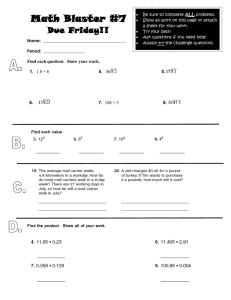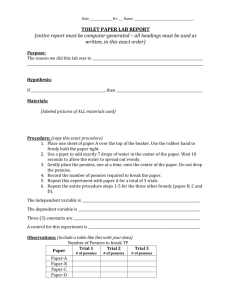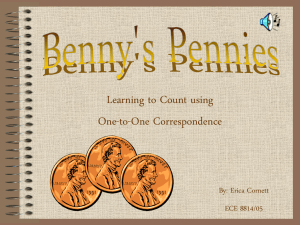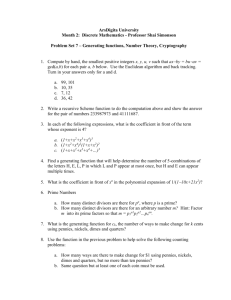Solutions to Eight Mathematical Games
advertisement
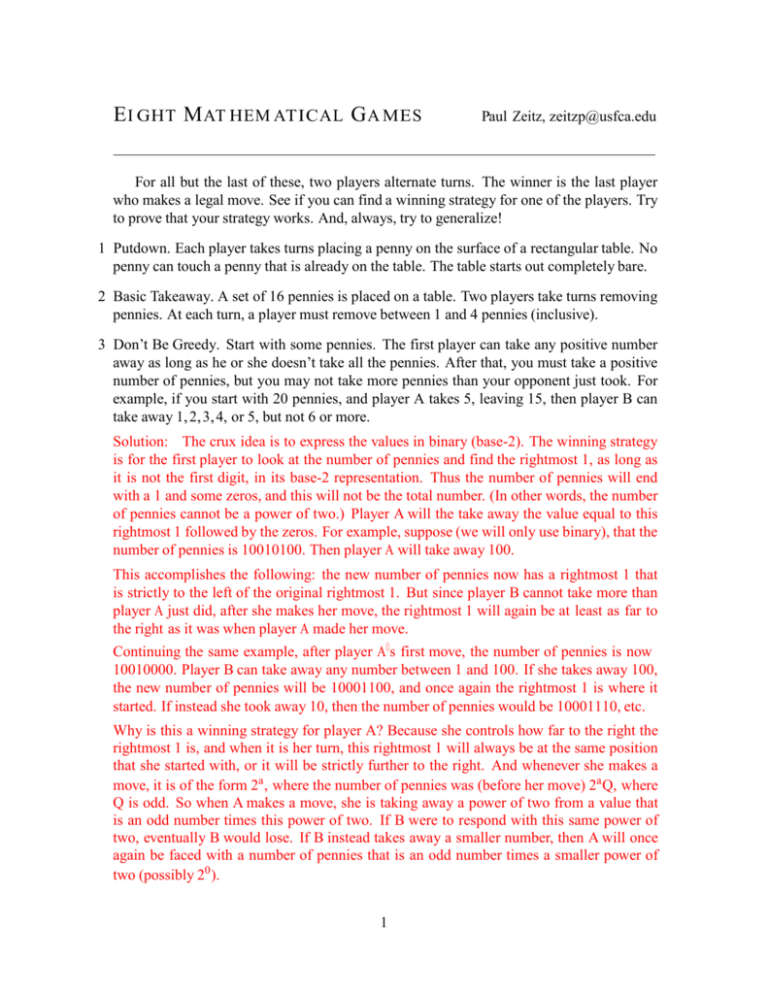
E I G H T M AT H EM AT I C A L G A M E S Paul Zeitz, zeitzp@usfca.edu For all but the last of these, two players alternate turns. The winner is the last player who makes a legal move. See if you can find a winning strategy for one of the players. Try to prove that your strategy works. And, always, try to generalize! 1 Putdown. Each player takes turns placing a penny on the surface of a rectangular table. No penny can touch a penny that is already on the table. The table starts out completely bare. 2 Basic Takeaway. A set of 16 pennies is placed on a table. Two players take turns removing pennies. At each turn, a player must remove between 1 and 4 pennies (inclusive). 3 Don’t Be Greedy. Start with some pennies. The first player can take any positive number away as long as he or she doesn’t take all the pennies. After that, you must take a positive number of pennies, but you may not take more pennies than your opponent just took. For example, if you start with 20 pennies, and player A takes 5, leaving 15, then player B can take away 1, 2, 3, 4, or 5, but not 6 or more. Solution: The crux idea is to express the values in binary (base-2). The winning strategy is for the first player to look at the number of pennies and find the rightmost 1, as long as it is not the first digit, in its base-2 representation. Thus the number of pennies will end with a 1 and some zeros, and this will not be the total number. (In other words, the number of pennies cannot be a power of two.) Player A will the take away the value equal to this rightmost 1 followed by the zeros. For example, suppose (we will only use binary), that the number of pennies is 10010100. Then player A will take away 100. This accomplishes the following: the new number of pennies now has a rightmost 1 that is strictly to the left of the original rightmost 1. But since player B cannot take more than player A just did, after she makes her move, the rightmost 1 will again be at least as far to the right as it was when player A made her move. Continuing the same example, after player A0 s first move, the number of pennies is now 10010000. Player B can take away any number between 1 and 100. If she takes away 100, the new number of pennies will be 10001100, and once again the rightmost 1 is where it started. If instead she took away 10, then the number of pennies would be 10001110, etc. Why is this a winning strategy for player A? Because she controls how far to the right the rightmost 1 is, and when it is her turn, this rightmost 1 will always be at the same position that she started with, or it will be strictly further to the right. And whenever she makes a move, it is of the form 2a , where the number of pennies was (before her move) 2a Q, where Q is odd. So when A makes a move, she is taking away a power of two from a value that is an odd number times this power of two. If B were to respond with this same power of two, eventually B would lose. If B instead takes away a smaller number, then A will once again be faced with a number of pennies that is an odd number times a smaller power of two (possibly 20 ). 1 If the starting number of pennies is a power of two, then A cannot win as long as B plays optimally. 4 Don’t Be Doubly Greedy. This is just like Don’t Be Greedy, only now the rule is that you cannot take more than twice what your opponent just took. So if player A takes 5, player B can take any number between 1 and 10, inclusive. Solution: Instead of base-2, we use base-F, the so-called “base Fibonacci” or Zeckendorf representation, writing the number of pennies as a sum of fibonacci numbers with the stipulation that two consecutive fibonacci numbers are not allowed. For example, 10 = 8 + 2, so in base-F, we get 10010. Now the strategy works the same way as before: As long as the starting value is not a Fibonacci number, player A begins by “removing the rightmost 1,” and this will be a winning strategy. The key idea behind this strategy is the fact that Fk+2 is always more than twice Fk , since Fk+2 = Fk+1 + Fk , and Fk+1 ≥ Fk . For example, suppose we are starting with 20 pennies, which is 13 + 5 + 2 or 101010F . Player A takes away a value equal to the rightmost 1 followed by any zeros that may occur to the right of it. We will call this a “rightmost 1” move. In this case, player A takes away 10F or 2 pennies, leaving the value 18 = 101000F . Since there can be no consecutive 1s in base-F, the rightmost 1 in this new number is always at least two places to the left of where it was before A moved. Now player B can take between 1 and 4 pennies, inclusive. Notice that 4 is strictly less than 5, which two fibonacci numbers after 2. In other words, player B will end up taking away a value that may have a 1 on the spot to the left of what A took away, but not two spots to the left. Consequently, B cannot remove the rightmost 1. For example, suppose that B takes away 3 = 100F . Now the number of pennies will be 15 = 13 + 2 = 100010F . Following the same strategy, A takes away 10F = 2 pennies, leaving 13 = 100000F . Once again, B can take between 1 and 4. Suppose now that B takes 4 = 101F . Now there are 9 = 10001F pennies left, and A’s response will be to take away just 1, leaving 8 = 10000F . So we see that as long as the starting value is not a Fibonacci number, player A can always perform a rightmost 1 move, but B can never respond with a rightmost 1 move. Among other things, B will never be able to take the last pennies, because B is always stuck with removing a value whose starting digit is at most one to the left of the starting digit of what A removed, yet the number of pennies has a starting digit that is at least two spots to the left of what A removed. Eventually, A will have a Fibonacci number of pennies, and will be able to perform a rightmost 1 move on this, taking away the entire number and winning. One full example, to see the entire process: Start with 36 = 34 + 2 = 10000010F . Also, keep in mind that one never takes more than one-third of the number of pennies, since the next player could then take at most two-thirds and win. A B A B A B A B A B A B A B A B A B A take 2 = 10 3 = 100 2 = 10 4 = 101 1=1 2 = 10 1=1 1=1 2 = 10 3 = 100 2 = 10 3 = 100 2 = 10 2 = 10 1=1 1=1 1=1 1=1 2 = 10 left 34 = 10000000 31 = 1010010 29 = 1010000 25 = 1000101 24 = 1000100 22 = 1000001 21 = 1000000 20 = 101010 18 = 101000 15 = 100010 13 = 100000 10 = 10010 8 = 10000 6 = 1001 5 = 1000 4 = 101 3 = 100 2 = 10 WIN! 5 Divide and Conquer. Start with 100 pennies. Each player can remove a divisor of the number of pennies remaining as long as the divisor is strictly less than the number of pennies remaining. For example, at the start, A could remove 1, 2, 4, 10, 20, 25, or 50 pennies, but not 100 pennies. This game ends when exactly 1 penny is left, since the only divisor of 1 is 1, which is not less than 1. 6 Nim. Start with several piles of beans. A legal move consists of removing one or more beans from a pile. (a) Verify that this game is very easy to play if you start with just one pile, for example, of 17 beans. (b) Likewise, if the game starts with two piles, the game is quite easy to analyze. Do it! (c) But what if we start with three or more piles? For example, how do we play the game if it starts with three piles of 17, 11, and 8 beans, respectively? What about four piles? More? 7 Puppies and Kittens. We start with a pile of 7 kittens and 10 puppies. Two players take turns; a legal move is removing any number of puppies or any number of kittens or an equal number of both puppies and kittens. 8 Cat and Mouse. (Adapted from Ravi Vakil’s excellent book, A Mathematical Mosaic.) A very polite cat chases an equally polite mouse. They take turns moving on the grid depicted below. 2 1 C 3 M Initially, the cat is at the point labeled C; the mouse is at M. The cat goes first, and can move to any neighboring point connected to it by a single edge. Thus the cat can go to points 1, 2, or 3, but no others, on its first turn. The cat wins if it can reach the mouse in 15 moves or less.
